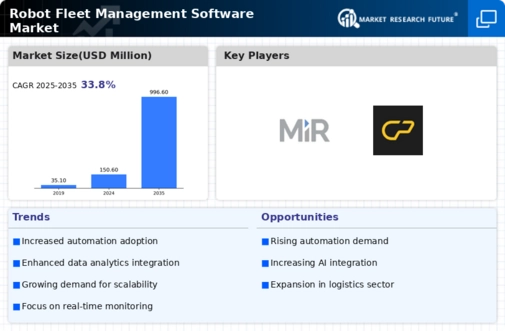Growing E-commerce Sector
The Global Robot Fleet Management Software Market Industry is significantly influenced by the growth of the e-commerce sector. As online shopping continues to expand, logistics and fulfillment centers are under pressure to enhance their operational capabilities. The integration of robotic fleets allows these centers to manage inventory more effectively and expedite order fulfillment. This trend is likely to drive the market from 150.6 USD Million in 2024 to a staggering 996.6 USD Million by 2035. Companies that adopt robot fleet management software can streamline their processes, reduce operational costs, and improve customer satisfaction, thereby capitalizing on the booming e-commerce landscape.
Market Growth Projections
The Global Robot Fleet Management Software Market Industry is poised for substantial growth, with projections indicating a market value of 996.6 USD Million by 2035. This growth trajectory is supported by a compound annual growth rate of 18.74% for the period from 2025 to 2035. The increasing integration of robotic systems across various sectors, coupled with advancements in software capabilities, suggests a robust demand for effective fleet management solutions. As organizations continue to seek efficiencies and optimize their operations, the market for robot fleet management software is likely to expand significantly, reflecting the evolving landscape of automation.
Technological Advancements
Technological advancements play a pivotal role in shaping the Global Robot Fleet Management Software Market Industry. Innovations in artificial intelligence, machine learning, and Internet of Things (IoT) are enhancing the capabilities of robotic systems. These technologies enable more sophisticated fleet management solutions that can adapt to dynamic environments. As a result, organizations are increasingly investing in software that can harness these advancements to improve fleet coordination and decision-making. The expected compound annual growth rate of 18.74% from 2025 to 2035 reflects the industry's potential as businesses seek to leverage cutting-edge technologies to maintain a competitive edge.
Rising Demand for Efficiency
The Global Robot Fleet Management Software Market Industry is driven by the rising demand for efficiency in operations. Companies are increasingly recognizing the need to optimize resource allocation and minimize downtime. This is particularly evident in sectors like warehousing and distribution, where the integration of robotic fleets can significantly enhance throughput. The anticipated growth from 150.6 USD Million in 2024 to 996.6 USD Million by 2035 underscores the potential for software solutions that manage these fleets effectively. By leveraging data analytics and machine learning, businesses can achieve higher operational efficiency, thereby solidifying the role of robot fleet management software in modern enterprises.
Increased Automation Adoption
The Global Robot Fleet Management Software Market Industry experiences a surge in demand due to the increasing adoption of automation across various sectors. Industries such as manufacturing, logistics, and healthcare are integrating robotic systems to enhance operational efficiency. This trend is evidenced by the projected market value of 150.6 USD Million in 2024, indicating a robust growth trajectory. As organizations seek to optimize productivity and reduce labor costs, the implementation of robot fleet management software becomes essential. The software facilitates real-time monitoring and coordination of robotic fleets, thereby streamlining operations and improving overall performance.
Focus on Safety and Compliance
The Global Robot Fleet Management Software Market Industry is increasingly influenced by the focus on safety and compliance within industrial environments. As regulations surrounding workplace safety become more stringent, organizations are compelled to adopt technologies that ensure compliance while enhancing operational safety. Robot fleet management software provides tools for monitoring fleet performance and ensuring adherence to safety protocols. This focus on safety not only mitigates risks but also enhances productivity, as compliant operations tend to experience fewer disruptions. The growing emphasis on safety is likely to propel the market forward, aligning with the broader trends of operational excellence.













Leave a Comment